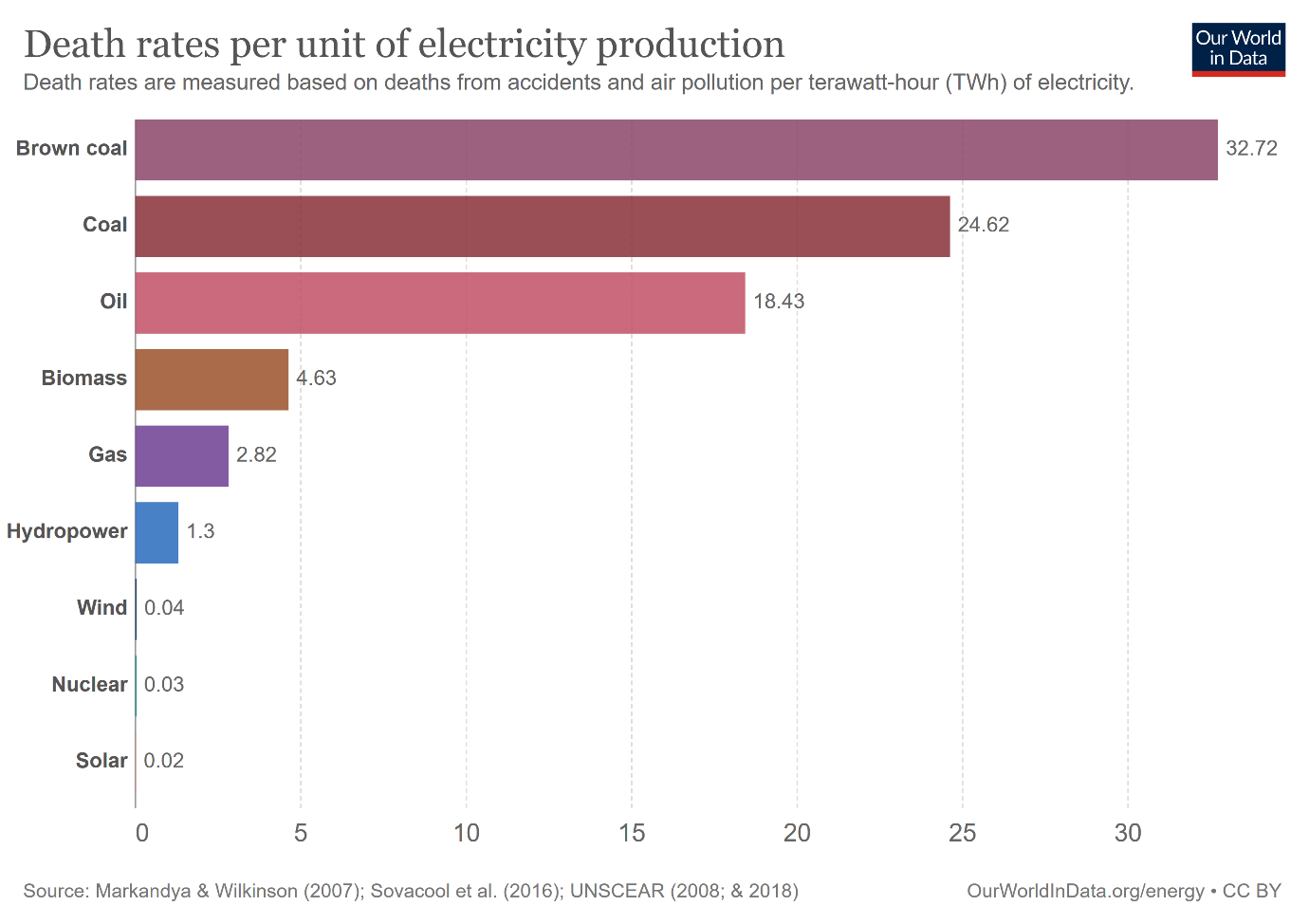I live less than 2 miles from the last remaining coal power station in England.
I would much rather have nuclear instead of a chimney chucking god knows what into the air (and subsequently into me) for my entire life.
Fun fact, coal plants produce more radiation into their environment than nuclear plants
Modern reactor designs are so damn safe it’s insane
If they are so damn safe why i can’t build one in my backyard?
Because the radioactive bits need to be handled by trained and trusted personnel because if those bits fall into the wrong hands they can be used for some horrible shit
so are you saying that it is not safe?
Have you ever been in a coal fired plant? Or even easier, been around a coal furnace for home heating? What about industrial environments?
That shit isn’t safe.
There are different levels of safety, personal reactors are on the other side of a cultural shift.
Everything can be unsafe if in the wrong hands
There are different degrees of safety associated with all things and we as a society have deemed nuclear power plants and their fuel as something that should only be in the hands of those trained and trusted in how to use it
If I install solar panels and the inverters incorrectly I could potentially harm or kill myself and others. Therefore solar isn’t safe.
But then why you can build these in your garden and not nuclear?
Such a dumb question.
Building a nuclear power plant requires the collaboration of physicists, nuclear + electrical + civil engineers, etc…
Solar requires a certified electrician.
We know how to build nuclear safely, it just requires a lot more effort and oversight, therefore is not something you can build at home.
with the risk of feeding the troll, maybe this will sway some fence sitters from adopting this argument
because we allow people to shave (some even do it with straight razors, too - dangerous shite) themselves and others with little to no oversight but we don’t let them perform surgery without proper training that takes a decade or so to master. should that make surgery illegal?
also, if you want to talk safety for home implements just look at the number of people that die due to carbon monoxide poisoning (or sometimes explosions) because of improperly set up heating at home. did you know it’s illegal to operate on your own gas pipes without proper permits? yup, you need to be qualified for that so you don’t rig your house into an IED
or if you want to have some fun, play around with some improperly discharged fridge capacitors, and see what that gets you. yet, you still have a fridge, I’d wager. by your logic, if it’s allowed in a home, it’s safe, right?
Because crayon eaters like you would open them up.
If planes are safer than cars, why can’t I fly a Boeing 797-9 Dreamliner?
Chew on that for a while.
If planes are safer than cars, why can’t I fly a Boeing 797-9 Dreamliner?
Because perhaps they are not
That wasn’t fun at all.
I lived less than 2 miles from a coal power station (until they pulled it down). By the owners own admission, when it was running, it released about 60kg of radioactive material a year from stuff that was in the coal.
I would rather have a gun pointed at me than a bazooka, that doesn’t mean i should have a weapon pointed at me.
We can solve a problem without generating another one. There are better alternatives to nuclear.
It’s moot now. Economics is the main anti nuclear force at the moment. Large scale nuclear will remain a “it would have been nice”, a “why didn’t they just”.
That’s just how it is. Unfortunately most people have absolutely no understanding of that and just split between nuclear power bros and anti nuclear vegans.
Nuclear is good only for regions where there is no possibility to build wind and solar. In such regions/countries the government has to step in, take the loss and build nuclear.
For the love of everything, at least let’s stop decommissioning serviceable nuclear plants.
For real, God forbid we keep the actual safe, clean nuclear plants running
Looking at you, Germany…
My understanding is that they eventually become unserviceable as they age, because of mechanical/structular reasons, or because the costs of servicing them is so prohibitive that they are unserviceable economically.
That they definitely have a begin, middle, and end, life cycle.
Disproven by Russia. Maybe sometimes core is replaced because it uses unsafe design by current standards like in St. Petesburg.
100% right.
It doesn’t make any sense without reprocessing though, have to do both. Fortunately France and Finland have active programs.
The US needs to both learn how to do reprocessing again and build more plants.
France program is still on a crisis due to maintenance and drought
https://en.wikipedia.org/wiki/Nuclear_power_in_France#Crisis_since_late_2021
The maintenance crisis is under control, it will not be worse than past year.
Under control ? EDF Debt is around 100 billions, disponibility is around 58% and electricity price took +25% since two years…
EDF have been in debt for a very long time, they’ve been bought back by the state to restart a new plant generation. Disponibility has been worse and it was uncertain as the new maintenance issue was inspected everywhere. Now the global analysis is done and the maintenance has been aligned with the prediction for months, which calmed the market. Electricity price increase is multi-factorial: post COVID restart, war in Ukraine and new nuclear maintenance issue. It’s still under the effect of all of that and it will take a couple more years to come back to the previous situation, though still higher prices due to normal inflation and progressive carbon pricing.
If you’re worried about price variations, more renewable will make that worse. There are big variations of daily prices on the European market depending on wind in the North for example. Although thanks to the connected system, we can benefit from the right conditions from multiple parts of the continent.
I find it fascinating how few people remember the time when Greenpeace was literally selling Russian gas.
Could you expand on that please? (I sound a bit snarky but don’t mean to!)
@Kyoyeou@slrpnk.net seems to have given all the background info :)
I made it in response to this comment but wanted it to be a bit less hidden!
I’ve made a comment to the parent one with a link to the wiki article!
Reminds me of PETA throwing lobsters in fresh water.
From the Wikipedia Page
In “Climate and Energy”
Green Planet Energy
In 1999 Greenpeace Germany (NGO) founded Greenpeace Energy, a renewable electricity cooperative that supplied customers with fossil gas starting from 2011. After a 2021 media outcry about an entity associated with Greenpeace selling fossil fuel which has been described as greenwashing,[89] the cooperative changed its name to Green Planet Energy.[90] The Greenpeace Germany NGO retains one share in the cooperative, which has been criticized for “greenwashing” Russian gas.[89]
Link to article 89 Link to article 90
I am Kyoyeou, just a curious person. Not Bip Boop
I wonder what Greta’s take on nuclear is.
She’s probably going nuclear on Greenpeace.
The same as the experts she regularly refers to.
So in favour of nuclear as long as we are in the process of switching to renewables.
Which means she opposes what Ia Anstoot is saying. Thunberg does not view nuclear as a renewable in and of itself, and thus, like Greenpeace, she opposes EU Commission’s decision to include nuclear power in its classification system for sustainable finance (link).
Greta is very scientifically minded and rational, unlike how the media likes to portray her. They use the emotional sound bites and almost never show her referring to paper after paper.
I hate it that sometimes women are portrayed like that just because they’re women.
Even if media agencies are not setting out to portray someone like a caraciture they can not help it. That is just how the media is organized nowadays. If Greta shouts something angry in a microphone and they have 7 seconds for a segment about her, then they will use that outburst.
Neurotic men projecting their bullshit into other people.
Me to, but in this case, I think it’s because of politics.
That’s great to hear. 😊
holy crap a voice of reason, hopefully they listen. And hopefully she’s free to come scream at the climate activists here in the US too.
Not News. Not Reasonable.
Greenpeace was founded to be an anti-nuclear organization. See, most of the founding members were members of the Sierra Club (another environmentalist organization) but the Sierra Club was actually pro-nuclear power. The Sierra Club was actually fighting against the installation of new dams due to the effect of wiping out large swaths of river habitat and preventing salmon runs and such.
Anyway, in 1971 there was an underground nuclear bomb test by the US government in an area that was geologically unstable. (there were a bunch of tests to see just how geologically unstable). Protesters thought that the test would cause an earthquake and a tsunami.
Anyway, the people who were unhappy with the Sierra club not actively protesting nuclear power, wanted to protest this nuclear bomb test too, so they formed an organization called the “Don’t make a wave committee”. They sued, the suit was decided in the US’s favor, the test went off, and no earthquake happened (which is how the earlier tests said it would go).
At some point, the “Don’t make a wave committee” turned into Greenpeace.
Also about this timeframe, Greenpeace started receiving yearly donations from the Rockefeller Foundation.
The Rockefeller Foundation is the charitable foundation created by the Rockefeller heirs that “uses oil money to make the world a better place” but they kind of don’t. They’ve been anti-nuclear since the beginning, and even directly funded some radiation research in the 1950s that lied about safe exposure limits to radiation, claiming that there was no safe limit. That research went on to shape international policy, and by the time new research came out, the policy was already written and thus hard to change.
As a side note, another alumnus of the Sierra Club was approached by the then CEO of Atlantic Oil and directly paid a sum of something like $100k (in 1970 money) to found another anti-nuclear environmentalist organization called Friends of the Earth.
The Sierra Club and many other Western Environmental Groups have been receiving Russian money for a long time. Money that Russia is specifically spending to increase Western dependence on the Oil and Gas it sells. If it hampers a Western Nation’s O&G or Nuclear development then Russia wants to invest in it.
Any good sources on this that you could recommend?
https://www.rbf.org/grantees/greenpeace-fund-inc But the info is only the last 5 years. The Rockefeller fun has actually started to break with oil in the last 10 or so years. They’ve been greenwashing themselves.
Still, the Rockefeller foundation is very anti-nuclear. https://www.rockefellerfoundation.org/grant/nuclear-threat-initiative-2021-2/
Thanks for these!
I don’t think we should shutter existing nuclear plants, but renewables are a better idea than new nuclear plants
That’s a great plan to never actually decarbonize
I think we should do whatever decarbonizes us faster
Absolutely
Nuclear still has a much smaller footprint for power generation than renewables, at least solar and wind. I think “engineered safe” micro reactors can still play a part but as others have said those have been “20 years out” like Fusion for decades.
Solar can co-exist in the same space as other activities. It can exist in the same space at sheep in fields. It can exist atop rivers. Wind can exist out in the ocean. Those spaces are not available to Nuclear and some of those effectively take up no new space at all.
I’m all for new nuclear but we have to become more mature about waste management - and until then, no, keep the remaining units running, but focus all other effort into renweables.
I’m sure that there is some use for the waste, like it can be recycled.
tiny, teeny fractions of it have been experimented with, both for re-enrichment and also as raw fuel for other reactor types. No one’s running a waste-powered reactor atm.
"Approximately 97% – the vast majority (~94%) being uranium – of it could be used as fuel in certain types of reactor. "
could be. after processing that itself results in waste. and note that other caveat - in certain types of reactor. as in reactors specifically configured to run on recycled fuel. this is not the panacea you assume.
I didn’t assume anything, and I didn’t say it was perfect. I’ve just read up on it and said it’s a possibility. If that 97% turns out to be accurate, that’s good. Hugely better than coal or gas, and makes it a possible alternative to other green energy production methods. Which also arent perfect.
I’ve spent a lot of time around the nuclear industry. I think it’s better baseband power than fossil fuels. if I could flip a switch tomorrow and all the plants that had been built through the 90s were still going, sure, I’d love that route. Too many of those are gone. But thankfully solar and wind have become so ridiculously cheap at scale and deployable ready that arguing for a new investment in nuclear plants is hard to justify, especially conventional steam powered setups we’ve become used to. Bring in SMRs, but know those smaller setups can serve less and still generate the same kind of waste. Bring on breeder reactors that can run off other reactor’s waste output! But again know there will be radioisotope waste in some part of the pipeline. Molten salt closed loop setups for sure. But at six billion plus per unit, no, build solar and wind on gigantic scales please. Refurb and keep the old plants running, but don’t pursue a large nuclear component moving forward.
YMMV. We’ll need everyone to work together if we’re going to get our asses out of this shit. World wide, and coordinated.
lol looks like the right wingers finally got the one-world government they always feared… if they had only listened to Al Gore lol…
Actually that was really well written. Cheers.
One question though, something else I keep reading is that the blades for wind power can’t be recycled. Is this just bollocks being pushed by people that want nuclear power?
Also, cheers for not dragging me, which it seems you could have.
Renewables generate more toxic waste per mWh than any nuclear reactor design.
Your statement is specious at best and you need a full breakdown spelling out how you expect me to believe it with citations and evidence.
The Union of Concerned Scientists disagree, stating:
Despite these environmental impacts, renewable energy technologies compare extremely favorably to fossil fuels, and remain a core part of the solution to climate change.
Think it over: renewables produce industrial construction waste - carbon fiber, aluminum, composites etc., ONCE. during construction and erection (hehe). Then they run for decades. At the end of their lifecycle, especially for solar, there’s already tremendous effort going into recycling.
Your nuclear reactor is producing it 24/7/365 every day it’s in operation, for decades hopefully. But it also requires thousands of tons of concrete (huge emissions creator), a water supply that won’t ever be interrupted, and hardening against terrorist attack etc. Represents a shitton of material costs alone, before you get to processed fuel rods.
https://www.oneearth.org/the-7-reasons-why-nuclear-energy-is-not-the-answer-to-solve-climate-change/
Retaining the investment already made makes sense; crashing a program of nuclear plant production to meet the need - no. The enormous amount of time and energy used to create these plants, and the humongous regulatory hurdles in the way, with STILL NO CLEAR PATH FOR THE HORRIFIC NUCLEAR WASTE THEY PRODUCE, don’t justify it.
Finally, consider lifetime operational safety in a wildly changing climate: are we going to have more wildfires and hurricanes in the future? YES. Which is better to burn or tsunami - a coastal nuclear power station, or a wind farm? Drought is going to become a constant thing. How many wind farms melt down without water? Try that with a steam powered nuclear station.
deleted by creator
Lets not trade in polluting the air with polluting the ground and water even more.
The activist argues nuclear power is a crucial tool against climate change and disagrees with Greenpeace’s concerns about its environmental impact. Greenpeace defends its position, emphasizing the importance of prioritizing renewable alternatives like solar and wind for cutting emissions.
Nuclear, the costliest energy source available with massive room for long build projects and years of service contracts to manage the waste materials and deconstruction costs with at least nine figures. Cui bono?
Wind and solar ia cheap and save, batteries work. Build time is manageable.
Pretending that the baseload problem is solved for solar and wind doesn’t help anybody. “batteries work”, but not at the scale of the demands of a power utility when wind and solar happen not to be producing.
New nuclear installations will take 10 years and more. They will cost more then anyone is willing to pay. The math is clear, batteries and renewables like geo heat pumps, solar and wind are dead cheap in comparison.
Energy conservation is still the main goal.
Nuclear energy is the false promises that let us believe we can continue as we were.
Cue the nuclear shills that will handwave away any legitimate concern with wishful thinking and frame the discussion as solely pro/anti fossil, conveniently pretending that renewables don’t exist.
ETA:
Let’s look at some great examples of handwaving and other nonsense to further the nuclear agenda.
Here @danielbln@lemmy.world brings up a legitimate concern about companies not adhering to regulation and regulators being corrupt/bought *cough… Three Mile Island cough*, and how to deal with that:
So uh, turns out the energy companies are not exactly the most moral and rule abiding entities, and they love to pay off politicians and cut corners. How does one prevent that, as in the case of fission it has rather dire consequences?
So of course the answer to that by @Carighan@lemmy.world is a slippery slope argument and equating a hypothetical disaster with thousands if not millions of victims and areas being uninhabitable for years to come, with the death of a family member due to faulty wiring in your home:
Since you can apply that logic to everything, how can you ever build anything? Because all consequences are dire on a myopic scale, that is, if your partner dies because a single electrician cheaped out with the wiring in your building and got someone to sign off, “It’s not as bad as a nuclear disaster” isn’t exactly going to console them much.
At some point, you need to accept that making something illegal and trying to prosecute people has to be enough. For most situations. It’s not perfect. Sure. But nothing ever is. And no solution to energy is ever going to be perfect, either.
Then there’s the matter of misleading statistics and graphs.
Never mind the fact that the amount of victims of nuclear disasters is underreported, under-attributed and research is hampered if not outright blocked to further a nuclear agenda, also never mind that the risks are consistently underreported, lets leave those contentious points behind and look at what’s at hand.Here @JohnDClay@sh.itjust.works shows a graph from Our World in Data that is often thrown around and claims to show “Death rates by unit of electricity production”:

Seems shocking enough and I’m sure in rough lines, the proportions respective to one another make sense to some degree or another.
The problem however is that the source data is thrown together in such a way that it completely undermines the message the graph is trying to portray.According to Our World in Data this is the source of the data used in the graph:
Death rates from energy production is measured as the number of deaths by energy source per terawatt-hour (TWh) of electricity production.
Data on death rates from fossil fuels is sourced from Markandya, A., & Wilkinson, P. (2007).
Data on death rates from solar and wind is sourced from Sovacool et al. (2016) based on a database of accidents from these sources.
We estimate deaths rates for nuclear energy based on the latest death toll figures from Chernobyl and Fukushima as described in our article here: https://ourworldindata.org/what-was-the-death-toll-from-chernobyl-and-fukushima
We estimate death rates from hydropower based on an updated list of historical hydropower accidents, dating back to 1965, sourced primarily from the underlying database included in Sovacool et al. (2016). For more information, see our article: https://ourworldindata.org/safest-sources-of-energy
Fossil fuel numbers are based on this paper which starts out by described a pro-nuclear stance, but more importantly, does a lot of educated guesstimating on the air-pollution related death numbers that is straight up copied into the graph.
Sovacool is used for solar and wind, but doesn’t have those estimates and is mainly limited to direct victims.
Nuclear based deaths is based on Our World in Data’s own nuclear propaganda piece that mainly focuses on direct deaths and severely underplays non-direct deaths.
And hydropower bases deaths is based on accidents.
So they mix and match all kinds of different forms of data to make this graph, which is a no-no. Either you stick to only accidents, only direct deaths or do all possible deaths that is possibly caused by an energy source, like they do for fossil fuels.
Not doing so makes the graph seem like some kind of joke.















